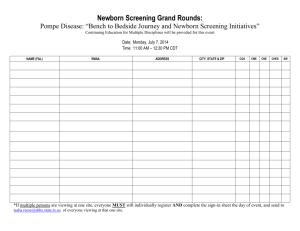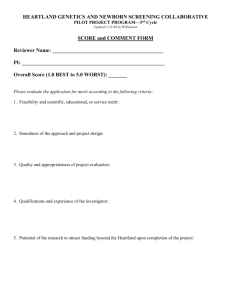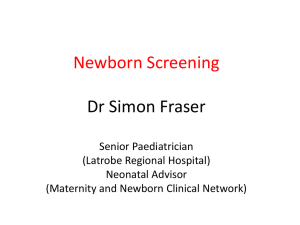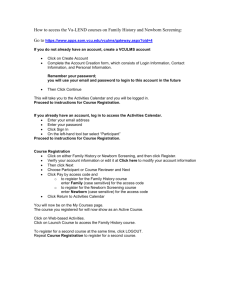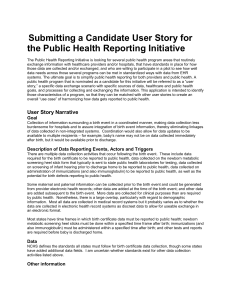Simon Fraser - Newborn Screening - Department of Education and
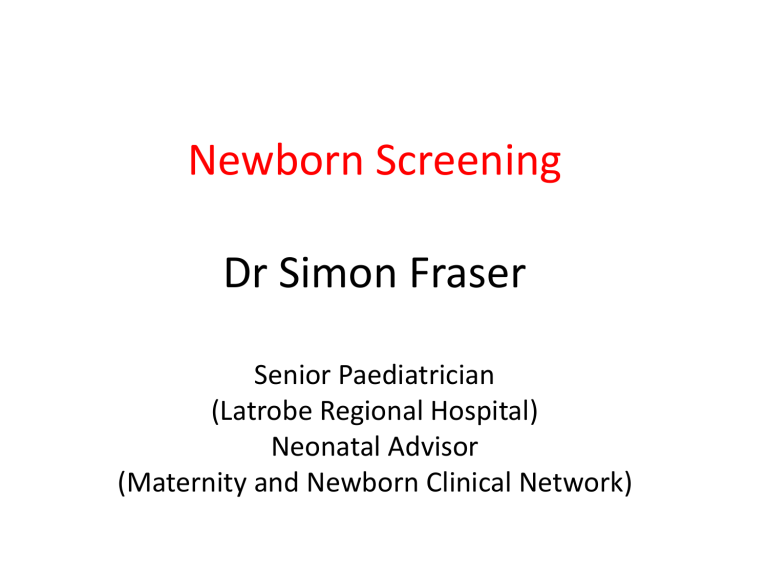
Newborn Screening
Dr Simon Fraser
Senior Paediatrician
(Latrobe Regional Hospital)
Neonatal Advisor
(Maternity and Newborn Clinical Network)
Newborn Screening
• Newborn screening (heel prick) test
• Hearing screening
• Newborn and 6 week examination
Screening – principles
• Serious disorder
• Sufficient frequency to be cost effective
• Cheap reliable screening test available
• Early treatment/intervention beneficial
• Consequences of non-treatment severe
Newborn screening (heel prick) test
• Not diagnostic
• Follow up testing required for abnormal results
• Not every affected child detected
• A screened condition that is suspected should always be tested formally
• Timing of sampling important
• Infant’s care giver will not be notified if the test is normal
Conditions screened
• Phenylketonuria (since 1965)
• Congenital hypothyroidism (since 1977)
• Cystic fibrosis (since 1989)
• Various inborn errors of metabolism (since
2002)
– MCAD (medium chain acyl CoA dehydrogenase deficiency most common
– Over 20 other rarer conditions
Pre-test procedure
• Parents given information leaflet
• Newborn screening test discussed
– Screening for many conditions
– May have to give second sample
– Most second samples within normal range
– Parents contacted if further testing necessary
• Consent on screening card (process if refused)
• All babies should be tested
Sample collection
• Information completed prior to test
• Sucrose for procedural pain management
• Blood collected 48-72 hours (not “day 2”)
• Capillary blood sampling preferable
• All 4 circles need to be completely filled
• Air dry in room temperature for 4 hours
• Avoid contamination
Special circumstances
• Total parenteral nutrition
• Palliated infants
• Having received blood products
• In utero blood transfusions
• Extremely low birthweight or premature infants
• Tables provide guidance for these
Further information
• Neonatal Handbook
– www.netsvic.org.au/nets/handbook
• RCH Clinical Guidelines
– www.rch.org.au/clinicalguide
• Victorian Clinical Genetic Services
– www.genetichealthvic.net.au
• Newborn Screening Laboratory
– www.vcgspathology.com.au/NBS
Hearing Screening
• Aims to identify babies born with hearing impairment even if not at risk
• Not diagnostic – positive result requires formal testing
• 1 in 1000 babies have permanent, moderate, severe or profound hearing loss at birth
• Technology easy, quick, reliable and immediate
Benefits of early diagnosis
• Improved language skills
• Education
• Social development
• Emotional development
Process
• Automated auditory brainstem response
(AABR)
• Painless
• Non-invasive
• Both ears checked simultaneously
• Takes about 4-7 minutes
Who is screened?
• Statewide
• Victorian Infant Hearing Screening Programme
• All babies within 1 month of age
• Most screened within 2 days of age (can be as young as 6 hours)
• Can be done after discharge
• Can be done down to 34 weeks (but usually closer to discharge)
Risk factors for hearing loss
• Meningitis/encephalitis
• Jaundice requiring exchange transfusion
• Ventilation > 5 days
• Aminoglycoside therapy > 3 days
• Congenital abnormality of head/neck
• Syndrome known to be related to hearing loss
• Close family history congenital hearing impairment
• Maternal infections during pregnancy (TORCH)
Referral to audiology (newborn)
• Diagnostic test
• Audiologist
• 4 - 6 weeks of age
• Referral made by VIHSP Coordinator
• Ongoing supports with diagnosis
• Reminders in green book at 2, 4 and 8 week visits (if not already done)
Referral to audiology (infant)
• VIHSP audiology referral form
• Can be used if need for assessment has changed
• Discuss hearing screen again at 8 months
• Refer if passed newborn screen with risk factor
• Refer if passed newborn screen with no risk factors but risk factor(s) now developed
Further information
• Neonatal Handbook
– www.netsvic.org.au/nets/handbook
• Victorian Infant Hearing Screening Program
– www.vihsp.org.au
• MCH Service
– www.education.vic.gov.au/mchservice
Newborn and 6 week examination equipment
• Stethoscope (cleaned)
• Ophthalmoscope
• Torch
• Tongue depressor
• Tape measure
Growth
Must measure:
• (Birth) weight
• (Birth) length
• (Birth) head circumference
• Plot for gestational age (usually known)
• Gestational age assessment charts available
• Need to correct for prematurity (if < 37/40)
Abnormal posture, tone, movements
• Floppy
• Stiff
• Asymmetry (Erb’s palsy)
• Jitters
• Seizures
Skull/scalp
• Abnormal shape – transient vs. fixed
• Fontanelles and sutures
• Lumps
– cephalhaematoma (common)
– congenital malformations (very rare)
• Plagiocephaly
Eyes
• Subconjunctival haemorrhage
• Conjunctivitis
• Sticky eye
• Red eye reflex – must be checked in all babies
– Cataracts
– White reflex
– Pigmented babies
• Unusually large eyes (glaucoma)
Mouth
• Asymmetry – facial palsy, congenital hypoplasia depressor anguli oris (wry smile)
• Natal teeth
• Tongue
• Cysts
• Cleft – only reliable way of excluding a soft palate cleft is to look
Neck
• Torticollis (sternomastoid ‘tumour’) – usually occurs later
• Cysts
• Webbing
• Fractured clavicle – lump +/- crepitus
Cardiac examination
• Apex beat
• Heaves
• Murmurs
• Femoral pulses
• (Four limb) blood pressure
• Heart failure – tachy x2 (-cardia, -pnoea) and megaly x2 (cardio-, hepato-)
Chest
• Signs of respiratory distress
• Colour
• Stridor
• Wheeze
• Symmetrical breath sounds
• Added sounds
– Wheeze
– Crackles
Abdomen
• Organomegaly (ballot kidneys)
• Distension
• Two vessel cord (association with renal anomalies)
• Omphalitis
• Umbilical hernia
• Anus (must actively look)
Genitalia
• Male:
– Hypospadias (dorsal hood, ventral meatus, chordee)
– Testes
– Hydrocoeles
• Female:
– Clitoromegaly
– Discharge (white, blood)
• Ambiguity
Lower limbs
• Hips:
– Risk factors – breech, first degree relative, other limb deformity, spina bifida
– www.ddheducation.com
• Feet:
– Talipes – equinovarus and calcaneovalgus
– Metatarsus adductus
• Toes:
– syndactyly
Examination - actively check
• Measure and plot
• Red eye reflex
• Cleft palate
• Murmurs
• Femoral pulses
• Hips
• Genital abnormalities and ambiguity
• Anus
